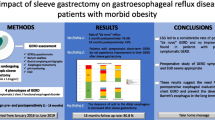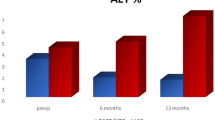Abstract
Background and purpose
The role of duodenogastroesophageal reflux (DGER) in gastroesophageal reflux disease (GERD) remains controversial. Few studies of reflux have compared patients with an intact stomach to those without intact stomach after gastroesophageal surgery. This study aimed to investigate differences of the refluxate between patients with and without prior gastroesophageal surgery and to assess the role of DGER in GERD.
Methods
One hundred patients (34% with reflux symptoms) were divided into four groups: 23 with an intact stomach, and 27, 42, and 8 with esophagectomy followed by gastric tube reconstruction, distal gastrectomy, and total gastrectomy, respectively. Reflux symptoms were evaluated, and endoscopy and simultaneous 24-h monitoring of esophageal pH and bilirubin were performed.
Results
Of 44 patients with increased DGER but without increased acid reflux, three had severe reflux esophagitis and seven had Barrett’s esophagus. DGER was most frequent under weakly acidic conditions in the intact stomach, esophagectomy, and distal gastrectomy groups. Pure acid reflux and DGER at any pH were elevated in GERD patients with an intact stomach, while weakly acidic and alkaline DGER were elevated in GERD patients after gastrectomy. Esophagectomy patients had reflux with the combined characteristics of those in the intact stomach and gastrectomy groups. Weakly acidic or alkaline DGER was correlated with symptoms and esophageal mucosal changes in gastrectomy patients.
Conclusion
The refluxate causing GERD differed between patients with and without prior gastroesophageal surgery. Weakly acidic or alkaline DGER may cause both symptoms and esophageal mucosal damage.





Similar content being viewed by others
References
Champion G, Richter JE, Vaezi MF, Singh S, Alexander R. Duodenogastroesophageal reflux: relationship to pH and importance in Barrett’s esophagus. Gastroenterology. 1994;107:747–54.
Kauer WK, Peters JH, DeMeester TR, Ireland AP, Bremner CG, Hagen JA. Mixed reflux of gastric and duodenal juices is more harmful to the esophagus than gastric juice alone. The need for surgical therapy re-emphasized. Ann Surg. 1995;222:525–31.
Vaezi MF, Richter JE. Role of acid and duodenogastroesophageal reflux in gastroesophageal reflux disease. Gastroenterology. 1996;111:1192–9.
Marshall RE, Anggiansah A, Owen WA, Owen WJ. Investigation of oesophageal reflux symptoms after gastric surgery with combined pH and bilirubin monitoring. Br J Surg. 1999;86:271–5.
Koek GH, Tack J, Sifrim D, Lerut T, Janssens J. The role of acid and duodenal gastroesophageal reflux in symptomatic GERD. Am J Gastroenterol. 2001;96:2033–40.
Osugi H, Higashino M, Kaseno S, Takada N, Takemura M, Ueno M, et al. Ambulatory intraesophageal bilirubin monitoring in Japanese patients with gastroesophageal reflux. J Gastroenterol. 2002;37:697–702.
Vaezi MF, Richter JE. Contribution of acid and duodenogastro-oesophageal reflux to oesophageal mucosal injury and symptoms in partial gastrectomy patients. Gut. 1997;41:297–302.
Yumiba T, Kawahara H, Nishikawa K, Inoue Y, Ito T, Matsuda H. Impact of esophageal bile exposure on the genesis of reflux esophagitis in the absence of gastric acid after total gastrectomy. Am J Gastroenterol. 2002;97:1647–52.
Öberg S, Johansson J, Wenner J, Walther B. Metaplastic columnar mucosa in the cervical esophagus after esophagectomy. Ann Surg. 2002;235:338–45.
Dresner SM, Griffin SM, Wayman J, Bennett MK, Hayes N, Raimes SA. Human model of duodenogastro-oesophageal reflux in the development of Barrett’s metaplasia. Br J Surg. 2003;90:1120–8.
O’Riordan JM, Tucker ON, Byrne PJ, McDonald GS, Ravi N, Keeling PW, et al. Factors influencing the development of Barrett’s epithelium in the esophageal remnant postesophagectomy. Am J Gastroenterol. 2004;99:205–11.
Yuasa N, Sasaki E, Ikeyama T, Miyake H, Nimura Y. Acid and duodenogastroesophageal reflux after esophagectomy with gastric tube reconstruction. Am J Gastroenterol. 2005;100:1021–7.
Nehra D, Howell P, Williams CP, Pye JK, Beynon J. Toxic bile acids in gastro-oesophageal reflux disease: influence of gastric acidity. Gut. 1999;44:598–602.
Marshall RE, Anggiansah A, Owen WA, Owen WJ. Investigation of gastro-oesophageal reflux in patients with an intact stomach: is oesophageal bilirubin monitoring a useful addition to pH monitoring? Scand J Gastroenterol. 2000;35:904–9.
Armstrong D, Bennett JR, Blum AL, Dent J, De Dombal FT, Galmiche JP, et al. The endoscopic assessment of esophagitis: a progress report on observer agreement. Gastroenterology. 1996;111:85–92.
Noda T. Angioarchitectural study of esophageal varices. With special reference to variceal rupture. Virchows Arch A Pathol Anat Histopathol. 1984;404:381–92.
Vianna A, Hayes PC, Moscoso G, Driver M, Portmann B, Westaby D, et al. Normal venous circulation of the gastroesophageal junction. A route to understanding varices. Gastroenterology. 1987;93:876–89.
Hoshihara Y, Kogure T, Yamamoto T, Hashimoto M, Hoteya O. Endoscopic diagnosis of Barrett’s esophagus. Nippon Rinsho. 2005;63:1394–8. (in Japanese with English abstract).
Jamieson JR, Stein HJ, DeMeester TR, Bonavina L, Schwizer W, Hinder RA, et al. Ambulatory 24-h esophageal pH monitoring: normal values, optimal thresholds, specificity, sensitivity, and reproducibility. Am J Gastroenterol. 1992;87:1102–11.
Bechi P, Pucciani F, Baldini F, Cosi F, Falciai R, Mazzanti R, et al. Long-term ambulatory enterogastric reflux monitoring. Validation of a new fiberoptic technique. Dig Dis Sci. 1993;38:1297–306.
Kinoshita Y, Kawanami C, Kishi K, Nakata H, Seino Y, Chiba T. Helicobacter pylori independent chronological change in gastric acid secretion in the Japanese. Gut. 1997;41:452–8.
Iijima K, Ohara S, Koike T, Sekine H, Shimosegawa T. Gastric acid secretion of normal Japanese subjects in relation to Helicobacter pylori infection, aging, and gender. Scand J Gastroenterol. 2004;39:709–16.
Harmon JW, Johnson LF, Maydonovitch CL. Effects of acid and bile salts on the rabbit esophageal mucosa. Dig Dis Sci. 1981;26:65–72.
Kivilaakso E, Fromm D, Silen W. Effect of bile salts and related compounds on isolated esophageal mucosa. Surgery. 1980;87:280–5.
Tack J, Koek G, Demedts I, Sifrim D, Janssens J. Gastroesophageal reflux disease poorly responsive to single-dose proton pump inhibitors in patients without Barrett’s esophagus: acid reflux, bile reflux, or both? Am J Gastroenterol. 2004;99:981–8.
Westhoff BC, Weston A, Cherian R, Sharma P. Development of Barrett’s esophagus six months after total gastrectomy. Am J Gastroenterol. 2004;99:2271–7.
Peitz U, Vieth M, Ebert M, Kahl S, Schulz HU, Roessner A, et al. Small-bowel metaplasia arising in the remnant esophagus after esophagojejunostomy. a prospective study in patients with a history of total gastrectomy. Am J Gastroenterol. 2005;100:2062–70.
Fukuhara K, Osugi H, Takada N, Takemura M, Higashino M, Kinoshita H. Reconstructive procedure after distal gastrectomy for gastric cancer that best prevents duodenogastroesophageal reflux. World J Surg. 2002;26:1452–7.
Author information
Authors and Affiliations
Corresponding author
Rights and permissions
About this article
Cite this article
Yuasa, N., Abe, T., Sasaki, E. et al. Comparison of gastroesophageal reflux in 100 patients with or without prior gastroesophageal surgery. J Gastroenterol 44, 650–658 (2009). https://doi.org/10.1007/s00535-009-0055-5
Received:
Accepted:
Published:
Issue Date:
DOI: https://doi.org/10.1007/s00535-009-0055-5




